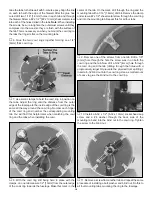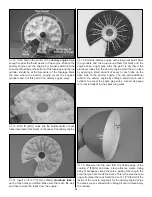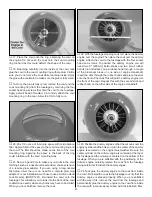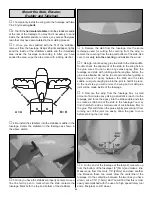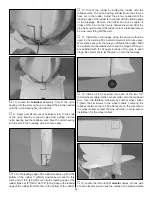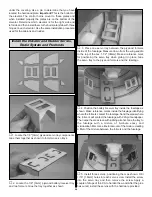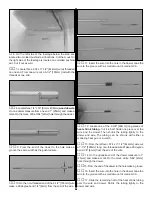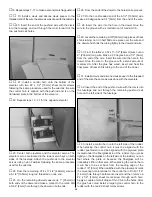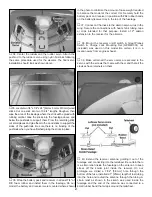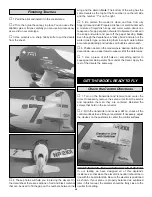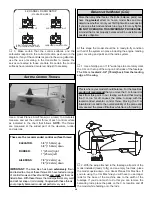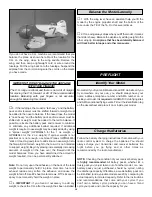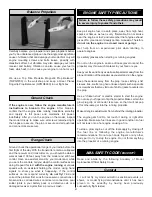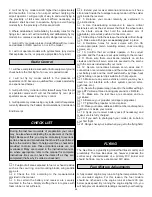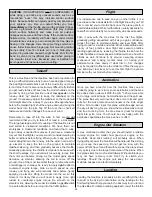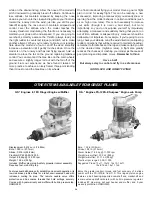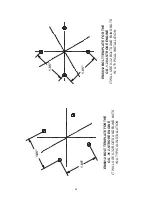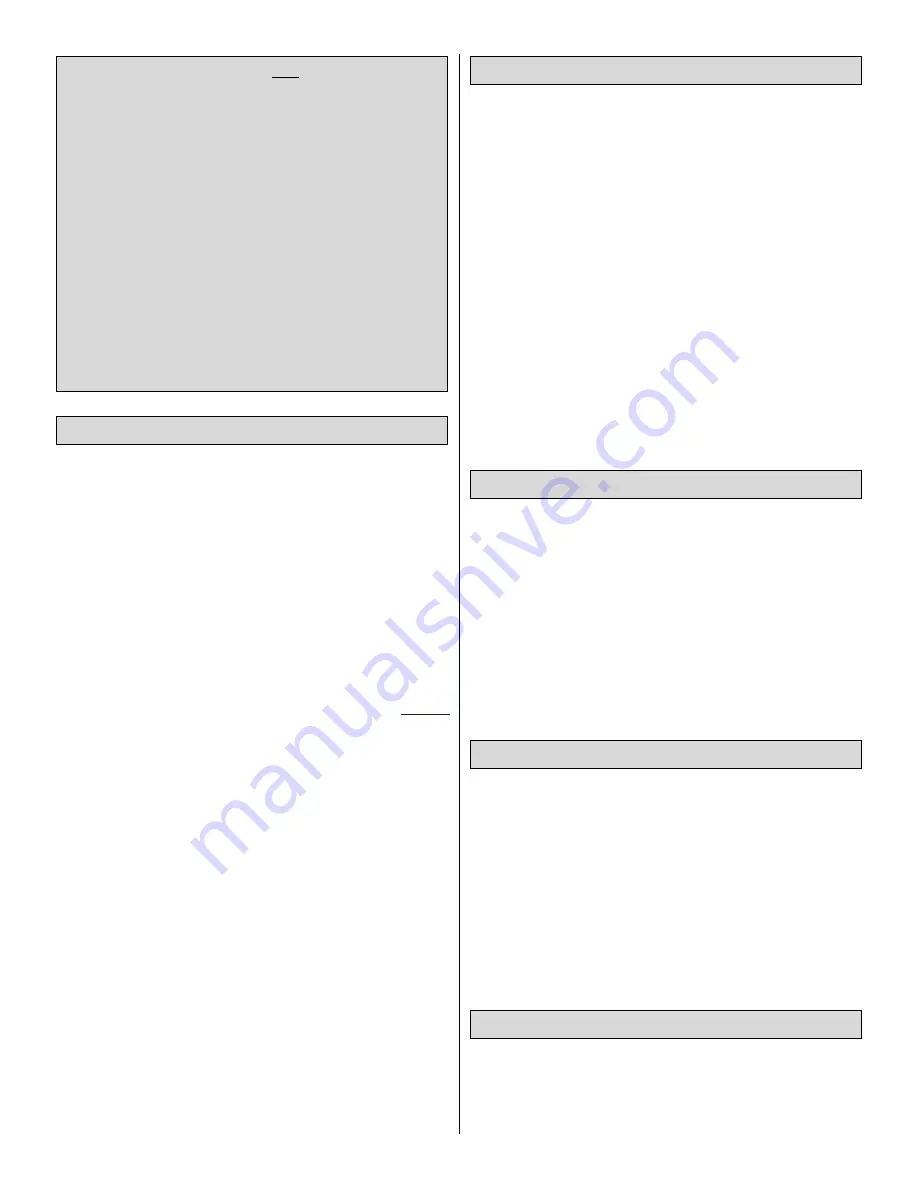
This is a Gee Bee and the Gee Bee has had a reputation for
being a difficult airplane to fly but we have designed many of
the bad flight characteristics out of the model. By no means
is it a trainer but it is also not extremely difficult to fly. Before
you get ready to take off, see how the model handles on the
ground by doing a few practice runs at low speeds on the
runway. Hold “up” elevator to keep the tailwheel on the
ground. If necessary, adjust the tailwheel so the model will
roll straight down the runway. If you are a little apprehensive
before the maiden flight, shut the engine down and bring the
model back into the pits. Top off the fuel, then check all
fasteners and control linkages for peace of mind.
Remember to take off into the wind. In fact, we
do not
recommend that you try to take off or land in a crosswind.
The large fuselage and short coupling of the Gee Bee is not
well suited to crosswind conditions. We have flown our
prototypes in crosswind conditions and found that a wide,
long runway is needed for success. If you have a crosswind
for your first few flights you may want to consider waiting for
better conditions before flying. When you're ready, point the
model straight down the runway, into the wind, hold a bit of
up elevator to keep the tail on the ground to maintain
tailwheel steering, and then gradually advance the throttle.
Gradually advancing the throttle is important because with
the short fuselage, if you advance it too quickly, torque from
the motor can become strong. As the model gains speed
decrease up elevator, allowing the tail to come off the
ground. One of the most important things to remember with
a tail dragger is to always be ready to apply right rudder to
counteract engine torque. Gain as much speed as your
runway and flying site will practically allow before gently
applying up elevator, lifting the model into the air. At this
moment it is likely that you will need to apply more right
rudder to counteract engine torque. Be smooth on the
elevator stick, allowing the model to establish a gentle climb
to a safe altitude before turning into the traffic pattern.
For reassurance and to keep an eye on other traffic, it is a
good idea to have an assistant on the flight line with you. Tell
him to remind you to throttle back once the plane gets to a
comfortable altitude. While full throttle is usually desirable for
takeoff, most models fly more smoothly at reduced speeds.
Take it easy with the Gee Bee for the first few flights,
gradually getting acquainted with it as you gain confidence.
Adjust the trims to maintain straight and level flight. After
flying around for a while and while still at a safe altitude with
plenty of fuel, practice slow flight and execute practice
landing approaches by reducing the throttle to see how the
model handles at slower speeds. Add power to see how she
climbs as well. Continue to fly around, executing various
maneuvers and making mental notes (or having your
assistant write them down) of what trim or C.G. changes
may be required to fine tune the model so it flies the way you
like. Mind your fuel level, but use this first flight to become
familiar with your model before landing.
Once you have a feel for how the Gee Bee flies you are
probably going to want to try some aerobatics and the Gee
Bee does them quite well. With the O.S.
®
1.20 we were able
to do large vertical loops, hammerheads and the split ess.
The plane flies very well inverted, does nice rolls and point
rolls but the most impressive maneuver is the knife edge!
With a bit of rudder input this plane will knife-edge across
the sky all day long. As you know the Gee Bee was a racer
and true to racing form, the Gee Bee is great for straight
flight into pylon turns. You should be very happy with the
aerobatic capabilities the Gee bee has to offer!
It was mentioned earlier that you should install a reliable
running engine. No matter how good your engine is, the
inevitable “dead stick landing” will probably occur. When
flying without power the Gee Bee will handle just fine as long
as you keep the speed up. Do not get too slow with the
power off! We have found that without power the plane slows
very quickly due to the large frontal area of the plane. When
the plane slows too much a stall follows. Without altitude you
may not have recovery room. Don't try to stretch your
landings. Should the engine quit, keep the nose down,
maintain airspeed and land immediately.
Landing the Gee Bee is probably a bit more difficult than the
take-off or the flying. Concentration on the landings for the
first few flights will help you learn the best way for you to land
the Gee Bee. To initiate a landing approach, lower the throttle
Landing
Engine Out Situation
Aerobatics
Flight
Takeoff
CAUTION: (THIS APPLIES TO ALL R/C AIRPLANES): If,
while flying, you notice any unusual sounds, such as a
low-pitched “buzz,” this may indicate control surface
flutter. Because flutter can quickly destroy components of
your airplane, any time you detect flutter you must
immediately cut the throttle and land the airplane! Check
all servo grommets for deterioration (this may indicate
which surface fluttered) and make sure all pushrod
linkages are secure and free of play. If the control surface
fluttered once, it probably will flutter again under similar
circumstances unless you can eliminate the free-play or
flexing in the linkages. Here are some things which can
cause flutter: Excessive hinge gap; Not mounting control
horns solidly; Poor fit of clevis pin in horn; Side-play of
pushrod in guide tube caused by tight bends; Poor fit of Z-
bend in servo arm; Insufficient glue used when gluing in
the elevator joiner wire; Excessive
play or backlash in
servo gears; and insecure servo mounting.
33

